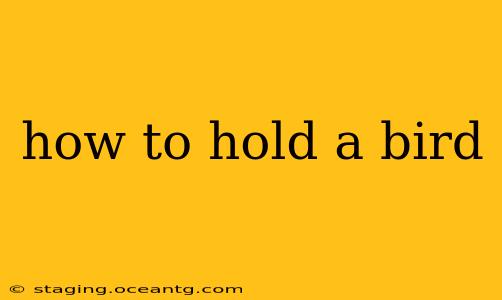Holding a bird can be a rewarding experience, fostering a closer bond between you and your feathered friend. However, it's crucial to understand how to do it safely and correctly to avoid stressing or injuring the bird. This guide will walk you through the process, addressing common concerns and ensuring a positive interaction for both you and your bird.
What Kind of Bird Do You Have?
Before we delve into the specifics of holding a bird, it's vital to consider the species. Different birds have different temperaments and physical characteristics. A tiny hummingbird requires a vastly different approach than a large parrot. The size, strength, and temperament of your bird will dictate the best handling technique. For example, small, delicate birds need extra gentle handling, while larger, more powerful birds might require more support. Knowing your bird’s specific needs is paramount.
How Do I Hold a Small Bird Safely?
Holding a small bird, such as a finch or canary, requires a gentle touch and a supportive hand. The best approach is to cup your hands together, forming a soft, secure nest. Gently guide the bird into your cupped hands, ensuring its feet have something to grip onto – the slight curve of your palms works well. Avoid squeezing too tightly; your hands should offer support without restricting movement. Keep your hands still and avoid sudden movements that could frighten the bird.
How Do I Hold a Larger Bird Safely?
Larger birds, like parrots, require a different approach. Their strength and size necessitate more support. You might need to use both hands, one supporting the body and the other supporting the feet and legs. Ensure your grip is firm but gentle, preventing the bird from struggling or escaping. Always be mindful of their beaks and claws, as they can cause injury. Consider using a perch or a towel to provide additional support, especially if the bird is particularly large or nervous.
What is the Best Way to Approach a Bird Before Holding It?
Approaching a bird before attempting to hold it is crucial for a successful and stress-free experience. Make slow, deliberate movements. Avoid sudden noises or jerky motions that might startle the bird. Speak in a soft, calming voice, allowing the bird to get used to your presence. Let the bird approach you if possible, rather than trying to force the interaction. Patience is key; rushing the process will likely result in a frightened and uncooperative bird.
How Long Should I Hold a Bird?
The length of time you hold a bird should be dictated by its comfort level. Some birds may only tolerate brief handling, while others might be more amenable to longer periods. Observe your bird's body language. Signs of stress include ruffled feathers, rapid breathing, or attempts to escape. If you see any of these signs, gently return the bird to its cage. Short, frequent interactions are generally better than one long, stressful session.
My Bird is Scared – What Should I Do?
If your bird shows signs of fear or distress, immediately return it to its cage. Continue to talk to it softly and offer reassurance. Avoid forcing interaction; a frightened bird is more likely to bite or injure itself. Give the bird time to calm down before attempting another interaction. Focus on building trust through positive reinforcement, offering treats, and gentle interactions at its own pace.
Are There Any Potential Risks When Handling Birds?
While holding a bird can be a rewarding experience, there are potential risks to consider. Birds can carry diseases, so always wash your hands thoroughly before and after handling. Be mindful of their beaks and claws, as they can cause injury. Avoid handling birds that appear ill or injured. If you're unsure about how to handle your bird safely, consult an avian veterinarian or a knowledgeable bird breeder.
By following these guidelines and prioritizing the well-being of your bird, you can enjoy many safe and happy moments together. Remember, patience and understanding are essential for a positive relationship with your avian companion.
